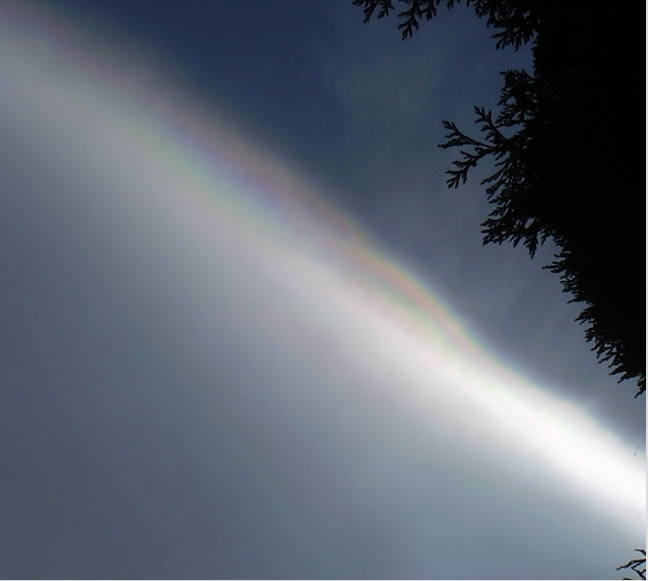Lenticular Cloud Iridescence
Lenticular Cloud Iridescence: A Spectacular Display of Colors in the Sky
Lenticular clouds are a fascinating meteorological phenomenon that often captivate observers with their unique shape and formation. These lens-shaped clouds form in the troposphere, typically at high altitudes, and are commonly associated with mountainous regions. While their distinctive appearance alone is enough to attract attention, lenticular clouds occasionally exhibit an additional awe-inspiring feature known as iridescence. In this article, we will delve into the world of lenticular cloud iridescence, exploring its causes, characteristics, and the science behind this mesmerizing display of colors in the sky.
Understanding Lenticular Clouds
Before diving into the phenomenon of lenticular cloud iridescence, it's essential to grasp the basics of lenticular clouds themselves. These clouds form when moist air encounters an obstruction, such as a mountain or hill. As the air is forced to ascend over the obstacle, it cools and condenses into a cloud. The unique shape of lenticular clouds is a result of the stable atmospheric conditions that allow them to maintain their form for extended periods.
The Origins of Iridescence
Iridescence, in general, refers to the phenomenon of certain surfaces displaying a range of colors that change depending on the angle of observation. This optical effect is caused by the interference and diffraction of light waves interacting with microscopic structures or particles. In the case of lenticular clouds, iridescence occurs when sunlight interacts with tiny water droplets or ice crystals within the cloud. These microscopic particles act as prisms, refracting and dispersing sunlight into its constituent colors.
The Science Behind Lenticular Cloud Iridescence
The intricate process behind lenticular cloud iridescence involves a combination of factors, including the size and distribution of water droplets or ice crystals within the cloud, the angle of the sun, and the observer's position. When sunlight passes through the cloud, it interacts with the particles suspended within it. The light waves are refracted and diffracted, causing them to interfere constructively or destructively. This interference results in the separation and scattering of colors, giving rise to the vibrant display of iridescence.
Characteristics of Lenticular Cloud Iridescence
Lenticular cloud iridescence is characterized by its vivid and shimmering appearance. The colors observed can range from pastel hues to vibrant shades, creating a striking contrast against the cloud's otherwise white or gray background. The colors often appear in bands or patches, with each band exhibiting a different color. These bands may appear stacked or layered, adding depth and complexity to the iridescent display.
Optimal Viewing Conditions
To witness lenticular cloud iridescence, specific conditions must align. Firstly, lenticular clouds themselves must be present, which typically occurs in mountainous areas or regions with significant topographical features. Secondly, the angle of the sun is crucial, as the sunlight needs to interact with the cloud particles at a particular angle to produce iridescence. Lastly, the observer's position plays a role in the visibility of iridescence. The best viewing conditions occur when the observer is situated at an angle that allows them to see the cloud and the sunlight interacting.
Common Misconceptions
Lenticular cloud iridescence is a captivating phenomenon that can sometimes lead to misconceptions or misinterpretations. One common misconception is that lenticular cloud iridescence is caused by pollution or human activity. However, it is important to note that lenticular clouds and their iridescence are natural occurrences and not directly influenced by human actions. Additionally, it is essential to differentiate between lenticular clouds and other cloud types, as not all clouds are capable of exhibiting iridescence.
The Beauty of Nature's Spectacle
Lenticular cloud iridescence serves as a reminder of the astonishing beauty and complexity of the natural world. The interplay of sunlight, water droplets or ice crystals, and atmospheric conditions creates a mesmerizing display that can leave observers in awe. Whether it is the soft pastels or the vibrant hues, lenticular cloud iridescence showcases the wonders of optics and meteorology, providing a glimpse into the intricate mechanisms that shape our skies.
In conclusion, lenticular cloud iridescence is a captivating phenomenon that adds an extra dimension of beauty to an already fascinating cloud formation. Understanding the science behind this optical spectacle enhances our appreciation for the wonders of nature. So, next time you find yourself gazing at the sky and spotting a lenticular cloud, keep an eye out for the breathtaking display of iridescence that may accompany it.

Iridescence in elongated altocumulus lenticularis. Taken by Kevin Boyle on 1st June 2006. That day saw widespread lenticular cloud over Southern England.
©Kevin Boyle, shown with permission.
Note: this article has been automatically converted from the old site and may not appear as intended. You can find the original article here.
Reference Atmospheric Optics
If you use any of the definitions, information, or data presented on Atmospheric Optics, please copy the link or reference below to properly credit us as the reference source. Thank you!
-
<a href="https://atoptics.co.uk/blog/lenticular-cloud-iridescence/">Lenticular Cloud Iridescence</a>
-
"Lenticular Cloud Iridescence". Atmospheric Optics. Accessed on November 26, 2024. https://atoptics.co.uk/blog/lenticular-cloud-iridescence/.
-
"Lenticular Cloud Iridescence". Atmospheric Optics, https://atoptics.co.uk/blog/lenticular-cloud-iridescence/. Accessed 26 November, 2024
-
Lenticular Cloud Iridescence. Atmospheric Optics. Retrieved from https://atoptics.co.uk/blog/lenticular-cloud-iridescence/.